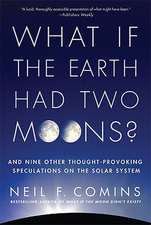Mars and How to Observe It: Astronomers' Observing Guides
Autor Peter Gregoen Limba Engleză Paperback – 7 iun 2012
The first part of Mars and How to Observe It sets out our current knowledge of Mars as a planet - its orbit, physical characteristics, evolution over time, and current geology. A planet-wide tour of Mars's topography is featured, along with clearly labeled maps and close-up images of a variety of features. The second part of the book explains how amateur and practical astronomers can observe Mars successfully. Many aspects are considered in depth, including preparing to observe, calculating phase and tilt, and making observational sketches and drawings. There are also plenty of details about how best to make high-resolution CCD images. Since Mars changes in its apparent size in the sky according to its position in relation to Earth, it is best observed during its closest approaches. Future apparitions (appearances of the Red Planet) are therefore featured.
Din seria Astronomers' Observing Guides
-
 Preț: 183.23 lei
Preț: 183.23 lei -
 Preț: 196.41 lei
Preț: 196.41 lei -
 Preț: 189.37 lei
Preț: 189.37 lei -
 Preț: 193.12 lei
Preț: 193.12 lei -
 Preț: 184.28 lei
Preț: 184.28 lei -
 Preț: 329.89 lei
Preț: 329.89 lei -
 Preț: 273.58 lei
Preț: 273.58 lei -
 Preț: 275.79 lei
Preț: 275.79 lei -
 Preț: 280.19 lei
Preț: 280.19 lei -
 Preț: 254.46 lei
Preț: 254.46 lei -
 Preț: 251.37 lei
Preț: 251.37 lei -
 Preț: 285.68 lei
Preț: 285.68 lei -
 Preț: 213.79 lei
Preț: 213.79 lei -
 Preț: 254.90 lei
Preț: 254.90 lei -
 Preț: 298.02 lei
Preț: 298.02 lei -
 Preț: 217.51 lei
Preț: 217.51 lei -
 Preț: 300.38 lei
Preț: 300.38 lei -
 Preț: 270.71 lei
Preț: 270.71 lei -
 Preț: 342.13 lei
Preț: 342.13 lei -
 Preț: 246.30 lei
Preț: 246.30 lei -
 Preț: 256.78 lei
Preț: 256.78 lei -
 Preț: 210.90 lei
Preț: 210.90 lei
Preț: 345.09 lei
Nou
Puncte Express: 518
Preț estimativ în valută:
66.04€ • 71.71$ • 55.47£
66.04€ • 71.71$ • 55.47£
Carte tipărită la comandă
Livrare economică 19-25 aprilie
Preluare comenzi: 021 569.72.76
Specificații
ISBN-13: 9781461423010
ISBN-10: 1461423015
Pagini: 300
Ilustrații: XIX, 238 p. 199 illus., 46 illus. in color.
Dimensiuni: 178 x 235 x 15 mm
Greutate: 0.64 kg
Ediția:2012
Editura: Springer
Colecția Springer
Seria Astronomers' Observing Guides
Locul publicării:New York, NY, United States
ISBN-10: 1461423015
Pagini: 300
Ilustrații: XIX, 238 p. 199 illus., 46 illus. in color.
Dimensiuni: 178 x 235 x 15 mm
Greutate: 0.64 kg
Ediția:2012
Editura: Springer
Colecția Springer
Seria Astronomers' Observing Guides
Locul publicării:New York, NY, United States
Public țintă
Popular/generalCuprins
About the Author.- Introduction.- Section I: Our Current Knowledge of Mars.- Chapter 1: Fourth Rock from the Sun.- Chapter 2: History of the Red Planet.- Chapter 3: Stuff and Substance.- Chapter 4: Atmospherics, Meteors, and Magentic Field.- Chapter 5: The Martian Moons.- Chapter 6: A Topographic Survey of Mars.- Section II: Observing Mars.- Chapter 7: Following Mars.- Chapter 8: A Tour of Mars.- Chapter 9: Recording Mars.- Chapter 10: An Observer's Guide to Martian Apparitions.- Chapter 11: The Mars Observer's Equipment.- Glossary.- Index.
Notă biografică
Peter Grego is an astronomy writer and editor. A regular watcher of the night skies since 1976, he observes from his home in St. Dennis, Cornwall, UK, with a variety of instruments. His telescopes include a 102 mm refractor, home-made 150 mm and 300 mm Newtonians (telescope mirror-making is another of his interests) and a 445 mm Newtonian, but his most-used instrument is his 200 mm SCT. Grego’s primary observing interests are the Moon’s topography, Mars and Jupiter. He now likes to use a hand-held computer to make observational drawings.
Grego has directed the Lunar Section of Britain’s Society for Popular Astronomy (SPA) since 1984, and since 2006 has been actively involved with the Lunar Section of the British Astronomical Association (BAA). He edits and produces four astronomy publications – Luna (journal of the SPA Lunar Section), The BAA Lunar Section Circulars and Popular Astronomy magazine. He is also layout editor for the Bulletin of the Society for the History of Astronomy and The Antiquarian Astronomer.
Grego’s astronomical writings and observations have been featured in many publications since 1983, including the BAS Newsletter, Popular Astronomy, The New Moon, Amateur Astronomy and Earth Sciences, Gnomon, The Lunar Observer, Yokohama Science Center News, and the CD-ROM Window on the Universe. Since 1997 he has written and illustrated the monthly MoonWatch page in UK’s Astronomy Now magazine, and he is the observing advisor and columnist for the Sky at Night magazine.
He has given many talks to astronomical societies around the UK and has been featured on a number of radio and television broadcasts.
Grego is the author of numerous astronomy books, including Collision:Earth! (Cassell, 1998), Moon Observer’s Guide (Philips/Firefly, 2004), The Moon and How to Observe It (Springer, 2005), Need to Know? Stargazing (Collins, 2005), Need to Know? Universe (Collins, 2006),Solar System Observer’s Guide (Philips/Firefly, 2005), Exploring the Earth/Exploring the Moon/ Discovering the Solar System/ Voyage Through Space/ Discovering the Universe (five books in the QED Space Guides series, 2007), Venus and Mercury and How to Observe Them (Springer, 2008), The Great Big Book of Space (QED 2010) and, Galileo and 400 Years of Telescopic Astronomy (Springer, 2010).
Grego has directed the Lunar Section of Britain’s Society for Popular Astronomy (SPA) since 1984, and since 2006 has been actively involved with the Lunar Section of the British Astronomical Association (BAA). He edits and produces four astronomy publications – Luna (journal of the SPA Lunar Section), The BAA Lunar Section Circulars and Popular Astronomy magazine. He is also layout editor for the Bulletin of the Society for the History of Astronomy and The Antiquarian Astronomer.
Grego’s astronomical writings and observations have been featured in many publications since 1983, including the BAS Newsletter, Popular Astronomy, The New Moon, Amateur Astronomy and Earth Sciences, Gnomon, The Lunar Observer, Yokohama Science Center News, and the CD-ROM Window on the Universe. Since 1997 he has written and illustrated the monthly MoonWatch page in UK’s Astronomy Now magazine, and he is the observing advisor and columnist for the Sky at Night magazine.
He has given many talks to astronomical societies around the UK and has been featured on a number of radio and television broadcasts.
Grego is the author of numerous astronomy books, including Collision:Earth! (Cassell, 1998), Moon Observer’s Guide (Philips/Firefly, 2004), The Moon and How to Observe It (Springer, 2005), Need to Know? Stargazing (Collins, 2005), Need to Know? Universe (Collins, 2006),Solar System Observer’s Guide (Philips/Firefly, 2005), Exploring the Earth/Exploring the Moon/ Discovering the Solar System/ Voyage Through Space/ Discovering the Universe (five books in the QED Space Guides series, 2007), Venus and Mercury and How to Observe Them (Springer, 2008), The Great Big Book of Space (QED 2010) and, Galileo and 400 Years of Telescopic Astronomy (Springer, 2010).
Textul de pe ultima copertă
Mars has long been a favorite subject for astronomers, both amateur and professional. Known as the Red Planet because of its distinct color, it shines brightly in the skies when it is closest to the Earth every two years. Exciting to view through a telescope, this most Earth-like of planets transforms into a real world showing phases, brilliant polar ice caps, seasonal changes in its dusty desert markings, and atmospheric phenomena.
Mars and How to Observe It takes readers on a planet-wide tour of the Red Planet and explains how a variety of dynamic forces has shaped it through the ages. This book explains how amateur astronomers can view Mars successfully to create accurate observational drawings and secure high-resolution CCD images of the planet.
Peter Grego is an accomplished author, an experienced amateur astronomer who has been actively observing Mars for over 30 years. Using the latest imagery and data from Mars probes and rovers, Mars and How to Observe It presents an up-to-date guide on our current understanding of the Red Planet and how the amateur astronomer can become familiar with this fascinating world.
Mars and How to Observe It takes readers on a planet-wide tour of the Red Planet and explains how a variety of dynamic forces has shaped it through the ages. This book explains how amateur astronomers can view Mars successfully to create accurate observational drawings and secure high-resolution CCD images of the planet.
Peter Grego is an accomplished author, an experienced amateur astronomer who has been actively observing Mars for over 30 years. Using the latest imagery and data from Mars probes and rovers, Mars and How to Observe It presents an up-to-date guide on our current understanding of the Red Planet and how the amateur astronomer can become familiar with this fascinating world.
Caracteristici
Uses the very latest imagery and data from Mars probes and rovers to present an up-to-date guide to Mars' geological history Contains a unique set of specially prepared maps, fully labeled, covering the entire Martian surface and Mars's moons Author is an accomplished author who is also an experienced amateur astronomer who has been actively observing Mars for over 25 years









